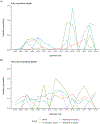Longitudinal patterns of use of stimulants and opioids in the AIDS linked to the IntraVenous experience cohort, 2005-2019
- PMID: 38408416
- PMCID: PMC11056308
- DOI: 10.1016/j.drugpo.2024.104364
Longitudinal patterns of use of stimulants and opioids in the AIDS linked to the IntraVenous experience cohort, 2005-2019
Abstract
Background: Overdoses involving opioids and stimulants are on the rise, yet few studies have examined longitudinal trends in use of both substances. We sought to describe use and co-use of opioids and stimulants, 2005-2019, in the AIDS Linked to the Intravenous Experience (ALIVE) cohort - a community-based cohort of people with a history of injection drug use living in or near Baltimore, MD.
Methods: We included 2083 ALIVE participants, who had at least two visits during the study period. Our outcome was based on self-reported use of opioids and stimulants in the prior 6 months. We estimated prevalence of 4 categories of use (neither stimulants nor opioids, only stimulants, only opioids, stimulants and opioids), using a non-parametric multi-state model, accounting for the competing event of death and weighting for informative loss to follow-up. All analyses were stratified by enrollment cohort, with the main analysis including participants who enrolled prior to 2015 and a sub-analysis including participants who enrolled 2015-2018.
Results: In the main analysis, prevalence of using stimulants and opioids decreased from 38 % in 2005 to 12 % 2013 but stabilized from 2014 onwards (13-19 %). The prevalence of using only stimulants (7-11 %) and only opioids (5-10 %) was stable across time. Participants who reported using both were more likely to report homelessness, depression, and other substance use (e.g., marijuana and heavy alcohol use) than participants in the other use categories. On average, 65 % of visits with use of both were followed by a subsequent visit with use of both; of participants transitioning out of using both, 13% transitioned to using neither.
Conclusions: While use of stimulants and opioids declined in the cohort through 2013, a meaningful proportion of participants persistently used both. More research is needed to understand and develop strategies to mitigate harms associated with persistent use of both stimulants and opioids.
Keywords: Cocaine; Heroin; Longitudinal analysis; Opioids; Prevalence; Stimulants.
Copyright © 2024. Published by Elsevier B.V.
Conflict of interest statement
Declaration of competing interest The authors declare that they have no known competing financial interests or personal relationships that could have appeared to influence the work reported in this paper.
Figures



References
Publication types
MeSH terms
Substances
Grants and funding
LinkOut - more resources
Full Text Sources

